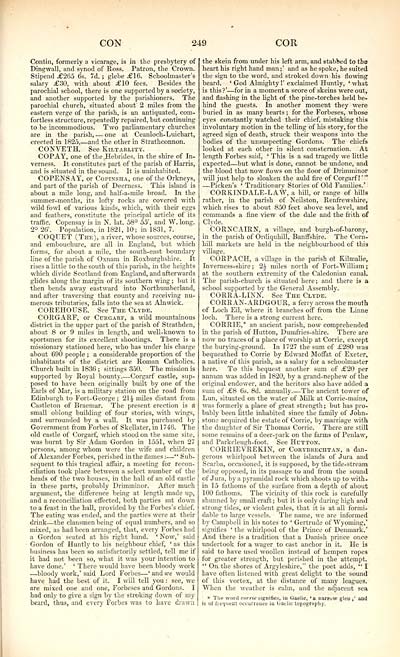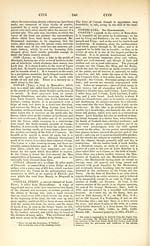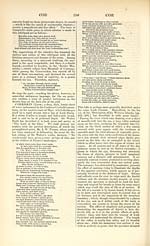Topographical, statistical, and historical gazetteer of Scotland > Volume 1
(329) Page 249 - CON
Download files
Complete book:
Individual page:
Thumbnail gallery: Grid view | List view

CON
249
COR
Contin, formerly a vicarage, is in the presbytery of
Dingwall, and synod of Ross. Patron, the Crown.
Stipend .£265 6s. 7d. ; glebe £16. Schoolmaster's
salary .£30, with about £10 fees. Besides the
parochial school, there is one supported by a society,
and another supported by the parishioners. The
parochial church, situated about 2 miles from the
eastern verge of the parish, is an antiquated, com-
fortless structure, repeatedly repaired, but continuing
to be incommodious. Two parliamentary churches
are in the parish, — one at Ceanloch-Luichart,
erected in 1825, — and the other in Strathconnon.
CONVETH. See Kiltarlity.
COPAY, one of the Hebrides, in the shire of In-
verness. It constitutes part of the parish of Harris,
and is situated in the sound. It is uninhabited.
COPENSAY, or Copinsha, one of the Orkneys,
and part of the parish of Deerness. This island is
about a mile long, and half-a-mile broad. In the
summer-months, its lofty rocks are covered with
wild fowl of various kinds, which, with their eggs
and feathers, constitute the principal article of its
traffic. Copensay is in N. lat. 58° 55', and W. long.
2° 26'. Population, in 1821, 10; in 1831, 7.
COQUET (The), a river, whose sources, course,
and embouchure, are all in England, but which
forms, for about a mile, the south-east boundary
line of the parish of Oxnam in Roxburghshire. It
rises a little to the south of this parish, in the heights
which divide Scotland from England, and afterwards
glides along the margin of its southern wing ; but it
then bends away eastward into Northumberland,
and after traversing that county and receiving nu-
merous tributaries, falls into the sea at Alnwick.
COREHOUSE. See The Clyde.
CORGARF, or Cuegarf, a wild mountainous
district in the upper part, of the parish of Strathden,
about 8 or 9 miles in length, and well-known to
sportsmen for its excellent shootings. There is a
missionary stationed here, who has under his charge
about 690 people ; a considerable proportion of the
inhabitants of the district are Roman Catholics.
Church built in 1836 ; sittings 350. The mission is
supported by Royal bounty Corgarf castle, sup-
posed to have been originally built by one of the
Earls of Mar, is a military station on the road from
Edinburgh to Fort-George ; 21 J miles distant from
Castleton of Braemar. The present erection is a
small oblong building of four stories, with wings,
and surrounded by a wall. It was purchased by
Government from Forbes of Skellater, in 1746. The
old castle of Corgarf, which stood on the same site,
was burnt by Sir Adam Gordon in 1551, when 27
persons, among whom were the wife and children
of Alexander Forbes, perished in the flames : — " Sub-
sequent to this tragical affair, a meeting for recon-
ciliation took place between a select number of the
heads of the two houses, in the hall of an old castle
in these parts, probably Drimminor. After much
argument, the difference being at length made up,
and a reconciliation effected, both parties sat down
to a feast in the hall, provided by the Forbes's chief.
The eating was ended, and the parties were at their
drink — the clansmen being of equal numbers, and so
mixed, as had been arranged, that, every Forbes had
a Gordon seated at his right hand. ' Now,' said
Gordon of Huntly to his neighbour chief, ' as this
business has been so satisfactorily settled, tell me if
it had not been so, what it was your intention to
have done.' ' There would have been bloody work
— bloody work,' said Lord Forbes — 'and?fe would
have had the best of it. I will tell you : see, we
are mixed one and one, Forbeses and Gordons. I
had only to give a sign by the stroking down of my
beard, thus, and every Forbes was to have drawn
the skein from under his left arm, and stabbed to tba
heart his right hand man ;' and as he spoke, he suited
the sign to the word, and stroked down his flowing
beard. ' God Almighty 1' exclaimed Huntly, ' what
is this?' — for in a moment a score of skeins were out,
and flashing in the light of the pine-torches held be-
hind the guests. In another moment they were
buried in as many hearts ; for the Forbeses, wliose
eyes constantly watched their chief, mistaking this
involuntary motion in the telling of his story, for the
agreed sign of death, struck their weapons into the
bodies of the unsuspecting Gordons. The chiefs
looked at each other in silent consternation. At
length Forbes said, ' This is a sad tragedy we little
expected — but what is done, cannot be undone, and
the blood that now flows on the floor of Drimminor
will just help to sloaken the auld fire of Corgarf! ' "
■ — Picken's ' Traditionary Stories of Old Families.'
CORKINDALE-LAW, a hill, or range of hills
rather, in the parish of Neilston, Renfrewshire,
which rises to about 850 feet above sea level, and
commands a fine view of the dale and the frith of
Clyde.
CORNCAIRN, a village, and burgh-of-barony,
in the parish of Ordiquhill, Banffshire. The Corn-
hill markets are held in the neighbourhood of this
village.
C0RPACH, a village in the parish ot Kilmalie,
Inverness-shire ; 24 miles north of Fort- William ;
at the southern extremity of the Caledonian canal.
The parish-church is situated here; and there is a
school supported by the General Assembly.
CORRA-LINN. See The Clyde.
CORRAN-ARDGOUR, a ferry across the mouth
of Loch Eil, where it branches off from the Linne
loch. There is a strong current here.
CORRIE,* an ancient parish, now comprehended
in the parish of Hutton, Dumfries-shire. There are
now no traces of a place of worship at Corrie, except
the hurying-ground. In 1727 the sum of £280 was
bequeathed to Corrie by Edward Moffat of Exeter,
a native of this parish, as a salary for a schoolmaster
here. To this bequest another sum of £20 per
annum was added in 1820, by a grand-nephew of the
original endower, and the heritors also have added a
sum of £8 6s. 8d. annually The ancient tower of
Lun, situated on the water of Milk at Corrie-mains,
was formerly a place of great strength ; but has pro-
bably been little inhabited since the family of John-
stone acquired the estate of Corrie, by marriage with
the daughter of Sir Thomas Corrie. There are still
some remains of a deer-park on the farms of Penlaw,
and Parkcleugh-foot. See Hctton.
CORRIEVREKIN, or Corybrechtan, a dan-
gerous whirlpool between the islands of Jura and
Scarba, occasioned, it is supposed, by the tide-stream
being opposed, in its passage to and from the sound
of Jura, by a pyramidal rock which shoots up to with-
in 15 fathoms of the surface from a depth of about
100 fathoms. The vicinity of this rock is carefully
shunned by small craft ; but it is only during high and
strong tides, or violent gales, that it is at all formi-
dable to large vessels. The name, we are informed
by Campbell in his notes to ' Gertrude of Wyoming,'
signifies 'the whirlpool of the Prince of Denmark.'
And there is a tradition that a Danish prince once
undertook for a wager to cast anchor in it. He is
said to have used woollen instead of hempen ropes
for greater strength, but perished in the attempt.
" On the shores of Argyleshire," the poet adds, " I
have often listened with great delight to the sound
of this vortex, at the distance of many leagues.
When the weather is calm, and the adjacent sea
* The word corrie signifies, in Gaelic, ' a narrow glen ;' and
is of frequent occurrence in Gaelic topogrnphy.
249
COR
Contin, formerly a vicarage, is in the presbytery of
Dingwall, and synod of Ross. Patron, the Crown.
Stipend .£265 6s. 7d. ; glebe £16. Schoolmaster's
salary .£30, with about £10 fees. Besides the
parochial school, there is one supported by a society,
and another supported by the parishioners. The
parochial church, situated about 2 miles from the
eastern verge of the parish, is an antiquated, com-
fortless structure, repeatedly repaired, but continuing
to be incommodious. Two parliamentary churches
are in the parish, — one at Ceanloch-Luichart,
erected in 1825, — and the other in Strathconnon.
CONVETH. See Kiltarlity.
COPAY, one of the Hebrides, in the shire of In-
verness. It constitutes part of the parish of Harris,
and is situated in the sound. It is uninhabited.
COPENSAY, or Copinsha, one of the Orkneys,
and part of the parish of Deerness. This island is
about a mile long, and half-a-mile broad. In the
summer-months, its lofty rocks are covered with
wild fowl of various kinds, which, with their eggs
and feathers, constitute the principal article of its
traffic. Copensay is in N. lat. 58° 55', and W. long.
2° 26'. Population, in 1821, 10; in 1831, 7.
COQUET (The), a river, whose sources, course,
and embouchure, are all in England, but which
forms, for about a mile, the south-east boundary
line of the parish of Oxnam in Roxburghshire. It
rises a little to the south of this parish, in the heights
which divide Scotland from England, and afterwards
glides along the margin of its southern wing ; but it
then bends away eastward into Northumberland,
and after traversing that county and receiving nu-
merous tributaries, falls into the sea at Alnwick.
COREHOUSE. See The Clyde.
CORGARF, or Cuegarf, a wild mountainous
district in the upper part, of the parish of Strathden,
about 8 or 9 miles in length, and well-known to
sportsmen for its excellent shootings. There is a
missionary stationed here, who has under his charge
about 690 people ; a considerable proportion of the
inhabitants of the district are Roman Catholics.
Church built in 1836 ; sittings 350. The mission is
supported by Royal bounty Corgarf castle, sup-
posed to have been originally built by one of the
Earls of Mar, is a military station on the road from
Edinburgh to Fort-George ; 21 J miles distant from
Castleton of Braemar. The present erection is a
small oblong building of four stories, with wings,
and surrounded by a wall. It was purchased by
Government from Forbes of Skellater, in 1746. The
old castle of Corgarf, which stood on the same site,
was burnt by Sir Adam Gordon in 1551, when 27
persons, among whom were the wife and children
of Alexander Forbes, perished in the flames : — " Sub-
sequent to this tragical affair, a meeting for recon-
ciliation took place between a select number of the
heads of the two houses, in the hall of an old castle
in these parts, probably Drimminor. After much
argument, the difference being at length made up,
and a reconciliation effected, both parties sat down
to a feast in the hall, provided by the Forbes's chief.
The eating was ended, and the parties were at their
drink — the clansmen being of equal numbers, and so
mixed, as had been arranged, that, every Forbes had
a Gordon seated at his right hand. ' Now,' said
Gordon of Huntly to his neighbour chief, ' as this
business has been so satisfactorily settled, tell me if
it had not been so, what it was your intention to
have done.' ' There would have been bloody work
— bloody work,' said Lord Forbes — 'and?fe would
have had the best of it. I will tell you : see, we
are mixed one and one, Forbeses and Gordons. I
had only to give a sign by the stroking down of my
beard, thus, and every Forbes was to have drawn
the skein from under his left arm, and stabbed to tba
heart his right hand man ;' and as he spoke, he suited
the sign to the word, and stroked down his flowing
beard. ' God Almighty 1' exclaimed Huntly, ' what
is this?' — for in a moment a score of skeins were out,
and flashing in the light of the pine-torches held be-
hind the guests. In another moment they were
buried in as many hearts ; for the Forbeses, wliose
eyes constantly watched their chief, mistaking this
involuntary motion in the telling of his story, for the
agreed sign of death, struck their weapons into the
bodies of the unsuspecting Gordons. The chiefs
looked at each other in silent consternation. At
length Forbes said, ' This is a sad tragedy we little
expected — but what is done, cannot be undone, and
the blood that now flows on the floor of Drimminor
will just help to sloaken the auld fire of Corgarf! ' "
■ — Picken's ' Traditionary Stories of Old Families.'
CORKINDALE-LAW, a hill, or range of hills
rather, in the parish of Neilston, Renfrewshire,
which rises to about 850 feet above sea level, and
commands a fine view of the dale and the frith of
Clyde.
CORNCAIRN, a village, and burgh-of-barony,
in the parish of Ordiquhill, Banffshire. The Corn-
hill markets are held in the neighbourhood of this
village.
C0RPACH, a village in the parish ot Kilmalie,
Inverness-shire ; 24 miles north of Fort- William ;
at the southern extremity of the Caledonian canal.
The parish-church is situated here; and there is a
school supported by the General Assembly.
CORRA-LINN. See The Clyde.
CORRAN-ARDGOUR, a ferry across the mouth
of Loch Eil, where it branches off from the Linne
loch. There is a strong current here.
CORRIE,* an ancient parish, now comprehended
in the parish of Hutton, Dumfries-shire. There are
now no traces of a place of worship at Corrie, except
the hurying-ground. In 1727 the sum of £280 was
bequeathed to Corrie by Edward Moffat of Exeter,
a native of this parish, as a salary for a schoolmaster
here. To this bequest another sum of £20 per
annum was added in 1820, by a grand-nephew of the
original endower, and the heritors also have added a
sum of £8 6s. 8d. annually The ancient tower of
Lun, situated on the water of Milk at Corrie-mains,
was formerly a place of great strength ; but has pro-
bably been little inhabited since the family of John-
stone acquired the estate of Corrie, by marriage with
the daughter of Sir Thomas Corrie. There are still
some remains of a deer-park on the farms of Penlaw,
and Parkcleugh-foot. See Hctton.
CORRIEVREKIN, or Corybrechtan, a dan-
gerous whirlpool between the islands of Jura and
Scarba, occasioned, it is supposed, by the tide-stream
being opposed, in its passage to and from the sound
of Jura, by a pyramidal rock which shoots up to with-
in 15 fathoms of the surface from a depth of about
100 fathoms. The vicinity of this rock is carefully
shunned by small craft ; but it is only during high and
strong tides, or violent gales, that it is at all formi-
dable to large vessels. The name, we are informed
by Campbell in his notes to ' Gertrude of Wyoming,'
signifies 'the whirlpool of the Prince of Denmark.'
And there is a tradition that a Danish prince once
undertook for a wager to cast anchor in it. He is
said to have used woollen instead of hempen ropes
for greater strength, but perished in the attempt.
" On the shores of Argyleshire," the poet adds, " I
have often listened with great delight to the sound
of this vortex, at the distance of many leagues.
When the weather is calm, and the adjacent sea
* The word corrie signifies, in Gaelic, ' a narrow glen ;' and
is of frequent occurrence in Gaelic topogrnphy.
Set display mode to: Large image | Transcription
Images and transcriptions on this page, including medium image downloads, may be used under the Creative Commons Attribution 4.0 International Licence unless otherwise stated. ![]()
| Gazetteers of Scotland, 1803-1901 > Topographical, statistical, and historical gazetteer of Scotland > Volume 1 > (329) Page 249 - CON |
|---|
| Permanent URL | https://digital.nls.uk/97441494 |
|---|
| Description | Volume first. A-H. |
|---|---|
| Attribution and copyright: |
|

